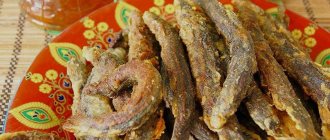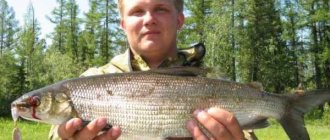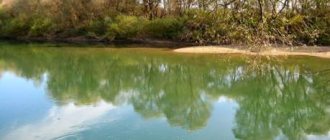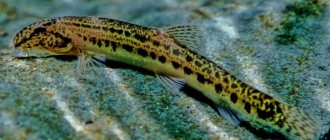- Wild animals
- >>
- Fish
The diversity of sea and river inhabitants is amazing. Among them there are quite cute creatures, and there are those who evoke fear or hostility with their appearance. The latter includes loach . Outwardly, they are very reminiscent of a snake, they wriggle strongly and make unpleasant sounds if caught. However, the loach is a very interesting fish, whose habits and lifestyle are worth learning more about.
Origin of the species and description
Photo: Vyun
Loaches are unique animals. They are a representative of a relatively small group of fish that have an elongated body and smooth scales. These fish have thread-like antennae on their lips. Outwardly, they are very similar to a snake or eel, but they are not. The loach belongs to the subfamily Cobitidae, the loach family. They form a separate genus of loaches. From the name you can understand that such fish can wriggle. Their body is flexible and elastic. Holding a loach in your hands is extremely difficult. Such an animal feels great in water and moves at high speed.
Interesting fact: Loach is a fish with unique natural abilities. Unlike other river inhabitants, it can easily tolerate drying out of water. When the river dries up, the loaches burrow into the bottom to a great depth - about fifty centimeters. This allows it to survive even under very dry silt.
Video: Vyun
Loaches are part of the huge family of loaches, which today includes about one hundred and seventy-seven species of fish. All fish are grouped into twenty-six genera.
The genus of loaches is quite large; among the most common species of these fish are:
- misgurnus fossilis or common loach. Distributed in Asia and Europe. The length of this river inhabitant often reaches thirty centimeters. The color of the back is brown, the belly is yellow;
- cobitis taenia. In Russian they call it ordinary spined loach. This is the tiniest member of the family. Lives in many European countries, Japan, China, CIS countries. The length of such a creature does not exceed ten centimeters. The color is predominantly light yellow;
- misgurnus anguillicaudatus or Amur loach. The population of such a river inhabitant is quite large in the reservoirs of Sakhalin, Siberia, China, Asia and Japan. In the wild, this animal reaches a length of twenty-five centimeters. The body color is light brown.
Description
Common loach
The loach fish has a slender, oval-shaped snake-like body with small slimy scales. The head is small with eyes located in the frontal part. The iris has a yellowish tint. There are mustaches around the mouth. Their number ranges from 6 to 12 pieces. No teeth. A characteristic feature of the fish is its tubular nostrils.
The fins are small. The caudal fin has a rounded shape. The color of the loach depends on its habitat. The dorsal part is dominated by brown shades with dark spots. Along the sides of the body, from the eyes to the caudal fin, there is a dark stripe. The belly is yellow, sometimes with a reddish tint.
The common loach grows up to 35 cm in length and can gain weight up to 140 g. But such specimens are rare. Individuals are more common - 15-18 cm. Life expectancy - up to 10 years.
Loach
Differences between loach and common loach:
- The body is more flattened. The compression is especially noticeable in the head part;
- There is a bipartite spine under the eye;
- The color is variegated. Gray and light yellow tones predominate;
- Dark spots located in a chaotic order are clearly visible on the body.
The spined loach grows up to 10 cm. Larger specimens are considered trophy.
Amur loach
The color of the Amur loach is dominated by light brown or yellowish-copper tones. Numerous populations live in water bodies of Siberia, northeast Asia and Sakhalin. In Europe, this type of loach is not numerous. The Amur loach grows up to 25 cm and can gain weight up to 130 grams. The record specimen was caught in the river. Amur. Its weight was 137 grams with a length of about 30 cm.
Appearance and features
Photo: What a loach looks like
The loach is quite easy to recognize. This is a fish with a thin body, the length of which ranges from ten to thirty-five centimeters. The scales of such a creature are either completely absent or very small and smooth. The body of the fish is completely streamlined, which makes it very maneuverable and fast.
Characteristic differences of loaches include small gills and eyes, thread-like antennae located on the lips.
The body of this fish is round. This anatomical feature is due to the fact that the loach is adapted for sharp and short swimming. He will not be able to move under the water for long. This animal covers the distance in short and sharp jerks. The fins are small and also round in shape. The body is thickly covered with mucus for additional protection.
The body color of most varieties of loaches is inconspicuous. The back is yellow-brown with dark spots, the belly is light yellow. The fins are brown, there is a dark solid stripe running down the center of the fish, and shorter stripes on the sides. In appearance, loaches resemble snakes. For this reason, many fishermen disdain such fish, although dishes made from it are very tasty.
Interesting fact: People who cunningly avoid danger or a direct answer are often called loaches. This nickname is closely related to the natural anatomical features of loach fish. They do everything to quickly escape in the water surface.
Loach fish are divided by gender into females and males. They can be distinguished by some external features. For example, ladies are always bigger. They surpass males not only in length, but also in weight. Males have longer pectoral fins. They have a pointed shape. In females, the pectoral fins are rounded, without thickening or other features.
Where does the loach live?
Photo: Loach underwater
Loaches are selective animals. Only quiet rivers and reservoirs, with trees on the banks and dense vegetation, are suitable for them. For this reason, such aquatic inhabitants can be found in remote channels, slow-flowing rivers, swampy places, ditches, lakes and ponds with a large layer of silt. Usually there are very few fish in such places. Loaches prefer to live at the bottom of reservoirs, where they find food for themselves. These fish spend most of their time in the mud, buried deep there.
Due to the presence of a large amount of mud and silt, these fish can live for a long time even in severe drought. If the swamp, lake or pond dries out, the loach can survive. It burrows deeply into the damp mud, and an additional respiratory organ helps it maintain its body in working order. It is a small part of the hindgut. Loaches easily adapt to their environment, so they are quite common around the planet.
The natural habitat includes the following areas:
- Europe;
- East and South Asia;
- Russia;
- Mongolia;
- Korea.
Loaches prefer temperate or warm climates. It is also very important for them to have enough food. In Asia, this fish is represented by the largest population. The population of Asian countries values loaches very much. There this fish is actively bred and eaten. In other territories, loaches are also valued from a scientific point of view. In many countries they are used as model objects for carrying out certain laboratory studies.
Now you know where the loach is found. Let's see what he eats.
Is it possible to eat loaches
In Russia, loaches are considered a low-value fish. In Asian countries, it is traditionally classified as a gourmet variety. Tender and fatty meat in the absence of large bones is a semi-finished product for a number of dishes. Unusual fish become decorations at the most special holidays.
In Russia there are also fans of preparing delicious dishes from loach. Standing water gives fish meat a specific smell of mud, so preference is given to fish from rivers or those raised in artificial reservoirs.
What does a loach eat?
Photo: Vyun
Loaches are excellent hunters. They catch and eat various small river inhabitants with great appetite. These fish find their food at the bottom of the reservoir. Few fish can boast such good hunting characteristics. For this reason, loaches often displace other fish from the reservoir, which simply do not have enough food. Tench, crucian carp and carp suffer from loaches more often than others. If you place the above fish in one small reservoir with loaches, then after a short period of time their number will greatly decrease.
The loach's daily diet includes various crustaceans and mollusks. Sometimes loaches eat mud, silt, and various river vegetation. Also, these river inhabitants love to eat insect larvae: bloodworms, mosquitoes. These insects live in swampy bodies of water. Alien caviar is also a favorite delicacy of loaches. These fish easily and quickly find it in any corner of a river or reservoir. Loaches eat caviar in unlimited quantities.
Interesting fact: Almost all of the loaches’ food lives at the bottom of a swampy pond or river. To find it, this fish uses touch. The loach's main sense of touch is its antennae. He has ten pairs of them, and the antennae are located in the corners of his mouth.
In captivity, the loach is also extremely voracious. But he can fast for up to six months. The diet of the “domestic” loach includes moths, earthworms, raw meat and ant eggs. Fish eat food only from the bottom.
Interesting facts about loaches
It takes quite a long time for a loach to develop from egg to adult fish – up to three years! But then it multiplies uncontrollably! The female lays up to 40 thousand eggs at a time! This process lasts from April to June without stopping! The fry grows up to 4 cm in a year. And having reached 13 cm, it is ready to become a parent.
Let us add that, before reaching sexual maturity, the loach becomes a notorious small predator and devours everything it can swallow. And he can swallow worms, bloodworms, larvae of any insects (special thanks for the larvae of mosquitoes and malaria), small crustaceans and mollusks, and most importantly - alien caviar!
Woe to those fish that spawn nearby! The loach has few competitors in its ability to find prey at the bottom of a pond, lake or river! Moreover, during the day it is almost not dangerous. Resting! But when it gets dark, watch out for the small fry! He'll eat it and won't notice.
Features of character and lifestyle
Photo: Vyun in Russia
The lifestyle of loaches is measured, calm, sedentary. They live in the chosen body of water until the end of their lives. They spend a lot of time buried deep in the mud. These fish choose swampy, stagnant waters for their habitat, where there are very few other fish or none at all. The loach prefers to spend most of its time in densely overgrown places where there is a lot of silt. In such swamps and reservoirs there is little oxygen, so you can often notice that loaches rise to the surface to release exhaust air and swallow fresh air. At such moments the animal makes a squeak. The same sound can be heard if you catch and hold a loach in your hands.
Interesting fact: Loach is generously endowed by nature with various properties. So, his skin is very sensitive to atmospheric pressure. If the weather is warm, then these fish rarely rise to the surface, and in bad weather (for example, before rain), the water surface begins to swarm with them.
Loaches spend almost the entire day in the mud, where they find food for themselves. They eat worms, crustaceans, and mollusks. They love to feast on other people's caviar. Loaches swim small, sharply and over short distances. They very deftly overcome various obstacles under water, thanks to their anatomical features: smooth scales, long body, rounded body shape. Loaches are very resourceful and tenacious. They are not afraid of drought and polluted water. They burrow deep into the silt and hibernate if the pond suddenly dries up. After the rain, these fish come back to life again.
Many experienced fishermen claim that loaches can easily move on land like snakes. If there are several bodies of water nearby, then large individuals can easily crawl from one to another. It is difficult to judge how true this fact is.
Living in natural conditions
Unpretentiousness to living conditions in the natural environment is one of the unique properties that the loach fish has. In reservoirs, especially those that often dry out and are silted, where other fish species cannot survive, loaches manage to live without any damage to their health. For breathing, the loach, like all other fish, uses gills, but if necessary, it can breathe through the surface of the skin and with the help of the intestines. If the water in the reservoir is not sufficiently saturated with oxygen, the loach takes air from the atmosphere: it floats to the surface, captures the air with its mouth and passes it through the intestines. At the same time, a sound reminiscent of a squeak is heard. This is what explains the other name for the loach - squeak.
Social structure and reproduction
Photo: River loach
The reproduction process of this type of fish has its own characteristics:
- The ideal time for reproduction is spring. The water in small reservoirs must warm up completely and get rid of ice;
- After mating, the female looks for a suitable place to place the eggs. Usually these fish lay their eggs in dense thickets near the shore. Sometimes eggs are deposited in temporary reservoirs, for example, during a river flood. In this case, there is a high risk of the fry dying when the river returns to its banks;
- the laid eggs are quite large, can reach a size of 1.9 millimeters. This is not surprising, because the parents of such fry themselves are large in size. The eggs have a thin shell and can stick to the leaves of aquatic plants;
- After emerging from the eggs, the fry attach to plants and feed on the yolk. At this time, all their organs and body are in constant development and acquire the necessary properties. After a short period of time, the fry begin to feed on their own.
They find suitable food for themselves with the help of their antennae, which perform the function of touch. The development of loach larvae occurs with a significant lack of oxygen. A little later, the fish will be able to grab air, rising to the surface. In the larval stage, they are helped to breathe by powerful blood vessels, and then by very long external gills. After becoming an adult, these gills decrease in size and then disappear completely. They are replaced by other, real gills.
Reproduction
Spawns
In spring and summer, in southern reservoirs, loaches often go to floods to spawn, and their larvae are then found far from the river or lake. The female spawns 100-150 thousand eggs among the algae. The eggs, 1.7-1.9 mm in diameter, are slightly sticky and slightly brownish in color. At a water temperature of 14-16° C, incubation lasts about 4 days.
The hatched prelarvae, 6.9 mm long, have adhesive organs and additional respiratory organs in the form of external gills. In addition, the larvae
the respiratory function is carried out by a dense network of blood vessels in the large pectoral fins, in the anal fold, and later in the posterior part of the intestine.
With a length of about 8 mm at the age of 12 days, the larvae switch to external feeding. They search for food using special sensory organs located around the mouth and on the antennae, which develop very early. At the age of 26 days, the external gills are completely reduced. The juvenile
period begins when the length reaches 30 mm.
Natural enemies of loaches
Photo: What a loach looks like
Loach is a resourceful, tenacious fish. She doesn't have many natural enemies. This is also due to its habitat. As a rule, loaches prefer to live in swampy bodies of water, where there are no other fish or only a small number of them live. However, there are still animals that eat loaches for food. The most dangerous natural enemies of loaches are predatory fish. Loach is an important part of the diet of burbot, pike and perch.
Of course, catching a loach is not easy even for predatory fish. Loaches can quickly hide from danger and burrow very deep into the silt. But sometimes even this does not help to get away from the predator. Loaches are also often attacked by birds. Loaches become prey for birds when they try to move to a neighboring body of water on wet grass. Some birds manage to get this fish right from the bottom of a half-dried pond or swamp. It is extremely rare for a loach on land to become prey for other predatory animals that happen to be nearby.
Humans can also be called an enemy of snake-like fish. The loach doesn't look very attractive. Many fishermen, having accidentally caught such a fish, simply throw it ashore. Other fishing enthusiasts specifically catch large quantities of loaches and then use them as bait.
Loach fishing
It is rarely caught specifically with a fishing rod, but in reservoirs where there are a lot of it, it bites greedily. The loach readily grabs earthworms, and with this bait it can be caught using a simple float rod. The bait is a worm, pieces of a worm, large bloodworms, ant eggs.
Where there are a lot of loaches, the easiest way to catch them is by basting, capturing the top layer of silt with a net. They also come across wire mesh-tops. In small bodies of water it is best to catch it using a frequently woven basket or a diving net.
It is also known as a good bait for catching many predatory fish, especially perch, burbot, eel and catfish. And what’s interesting is that the loach is the catfish’s favorite delicacy, and of all the live bait, the catfish gives the greatest preference to it. However, in many reservoirs, predators are very reluctant to take on the loach.










